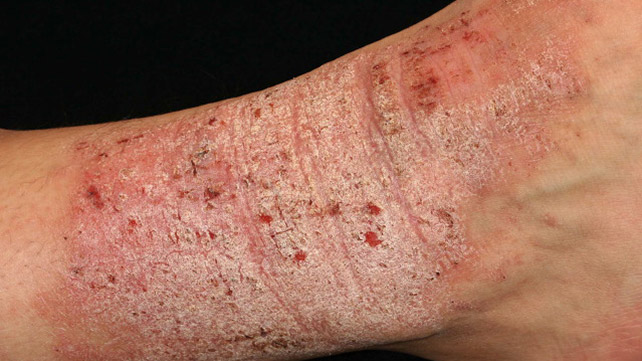ECZEMA

Definition: Eczema is a disease in a form of dermatitis, or inflammation of the epidermis. The term eczema is broadly applied to a range of persistent skin conditions. [1]
Other names: The term eczema refers to a set of clinical characteristics. Classification of the underlying diseases has been haphazard and unsystematic, with many synonyms used to describe the same condition. The most common type of eczema (atopic eczema) is sometimes just referred to as “eczema”.
Causes
This condition results from direct contact with one of many irritants or allergens. These can include food allergies, environmental factors such as dust or pollen, cosmetics and jewelry. [2]
Symptoms
These include dryness and recurring skin rashes that are characterized by one or more of these symptoms: redness, skin edema (swelling), itching and dryness, crusting, flaking, blistering, cracking, oozing, or bleeding. Areas of temporary skin discoloration may appear and are sometimes due to healed lesions. Scratching open a healing lesion may result in scarring. Eczema is often likely to be found on the flexor aspect of joints (inside elbows or behind knees, ect).
Complications
The open sores and fissures that can occur with dermatitis may become infected. Cellulitis, a bacterial infection of tissues under the skin, can also occur and appears as intensely inflamed skin that’s swollen, red, tender and warm to the touch, with spreading, indistinct margins. This can be life threatening if not treated, and if you suspect cellulitis you should see your doctor.[2] Scarring and changes in skin color are other potential complications. Most of these complications occur if the dry skin is scratched and opened to the environment.
Treatment
Eczema is often treated with corticosteroids (steroids), usually on the forms of lotion or other topical agents. For mild-moderate eczema a weak steroid may be used (e.g. hydrocortisone or desonide). [3] However, prolonged use of topical corticosteroids is thought to increase the risk of possible side effects, the most common of which is the skin becoming thin and fragile (atrophy).[4] More severe cases may require immunosupressents (such as Pimecrolimus, available as a topical cream) that effectively suppress the immune system in the affected area.
Eczema can be exacerbated by dryness of the skin. Moisturizing is one of the most important self-care treatments a patient can perform. A moisturizer should be applied within 3 minutes to trap the moisture from bath in the skin. [5]
Natural therapies include:
Evening primrose oil – This oil is a form of linoleic acid that’s available as an over-the-counter supplement. Evening primrose oil may benefit atopic dermatitis by improving deficient levels of essential fatty acids.
Omega-3 fatty acids – These nutrients, found in fish oil and flaxseed, have anti-inflammatory properties and may help improve skin rashes.
Chamomile creams – Studies have found that topical chamomile is about as potent as a product containing 0.25 percent hydrocortisone.
The number one treatment is to identify the allergen or cause of the eczema and to avoid that. Avoiding harsh soaps or detergents or other potential aggravating substances is important.
Resources
1. Eczema. Medline Plus http://www.nlm.nih.gov/cgi/mesh/2009/MB_cgi?mode=&term=Eczema
2. Eczema. The Mayo Clinic. http://www.mayoclinic.com/health/dermatitis-eczema/DS00339/DSECTION=complications
3. Hoare C, Li Wan Po A, Williams H (2000). “Systematic review of treatments for atopic eczema”. Health Technology Assessment 4 (37): 1–191.
4. Atherton DJ (October 2003). “Topical corticosteroids in atopic dermatitis”BMJ 327 (7421): 942–3.
5. “Daily Skin Care Essential to Control Atopic Dermatitis article at American Academy of Dermatology’s EczemaNet website”. http://www.skincarephysicians.com/eczemanet/daily_care.html. Retrieved 2009-03-24.


